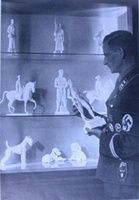Изготовитель Allach Porzellan Manufaktur
Купить фарфор Allach Porzellan Manufaktur. Продажа фарфоровых изделий на art-picture.ru
- Вначале высокая цена | низкая цена
Изготовитель Allach Porzellan Manufaktur

Историческая справка
На открытии выставочного зала фабрики Allach в Берлине на Лейпцигштрассе 13, 1 апреля 1939 года профессор Карл Дибич (Carl Diebitsch) произнёс слова, ставшие впоследствии пророческими:
Фабрика художественного фарфора Allach / Porzellan Manufaktur Allach — существовала в Германии в период между 1935 и 1945 годами. После первого года работы предприятие оказалось в ведении СС с использованием принудительного труда заключённых концентрационного лагеря Дахау.«Ни один народ не живет дольше, чем памятники его культуры. Эти слова фюрера – культурный девиз для нас. Мы хорошо понимаем, что всё, что мы делаем, будет тщательнейшим образом исследовано теми, кто придёт после нас. И мы не хотим, чтобы последующие поколения оценили нашу работу плохо».
Мастер керамики Франц Надь владел землей в пригороде Мюнхена — Аллаке (Allach), на которой был создан завод Allach, с 1925 года.
В начале 1935 года им была создана небольшая фарфоровая фабрика.
Официальная дата основания Allach GmbH с уставным капиталом 45 000 Рейхсмарок — 3 января 1936 года. Членами-учредителями были Франц Надь как руководитель предприятия, Теодор Кернер (Theodor Kärner) как скульптор, Карл Дибич как живописец и Бруно Галке (Bruno Galke) как торговый агент. Неофициальным владельцем фабрики являлся Генрих Гиммлер. В первую очередь фабрика ориентировалась на производство декоративного и художественного фарфора, в том числе спецзаказов от самого Рейхсфюрера, мечтавшего «воспитать» и развить новый немецкий художественный вкус. Также фабрикой осуществлялся более массовый выпуск домашней керамики и организация специальной секции посуды.
1 апреля 1939 года на открытии выставочного зала фабрики Allach в Берлине, на Лейпцигштрассе 13, профессор Карл Дибич произнёс слова, ставшие впоследствии пророческими: «Народ существует, пока живы свидетельства его культуры. Эти слова Фюрера — культурный девиз для нас. Мы хорошо понимаем, что всё, что мы делаем, будет тщательнейшим образом исследовано теми, кто придёт после нас. И мы не хотим, чтобы последующие поколения оценили нашу работу плохо».
Общий товарооборот фабрики в 1941 году составлял 560 000 рейхсмарок, в 1942 – 850 000 рейхсмарок, а к 1943 году насчитывал 706 000 рейхсмарок. Более половины фарфоровых изделий высочайшего качества и представлявших наибольшую ценность, поставлялось Личному отделу штата рейхсфюрера СС, уполномоченному использовать их в целях пропаганды, другие же шли в продажу. «Идеологический фарфор» адресовался высокопоставленным чинам СС и полиции, а также особо отличившимся рядовым членам организации СС. Избранные произведения, предназначавшиеся для самых высоких лиц, утверждались лично Гиммлером.
Отдельные изделия существовали в эксклюзивном исполнении, как, например, призовая тарелка полицейских соревнований 1937 года. Рядовому составу СС были доступны Йольфестовские тарелки (Йольфест – праздник зимнего солнцестояния, который должен был прийти на смену Рождеству), подсвечник и так называемые «Светильники Жизни». А при рождении четвертого и каждого последующего ребенка семье члена СС вручался так называемый «Светильник Жизни» с факсимиле Гиммлера и подписью: «В бесконечной цепи вы – одно звено. Вам, вашим родителям, вашим детям, вашей семье». Подсвечники исполнялись в виде керамических конусов с руническим орнаментом.
Фирменный знак мануфактуры представлял собой изображение двух рун СС, одна из которых как бы стояла над другой.

